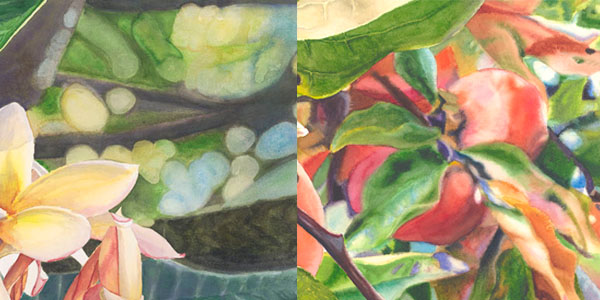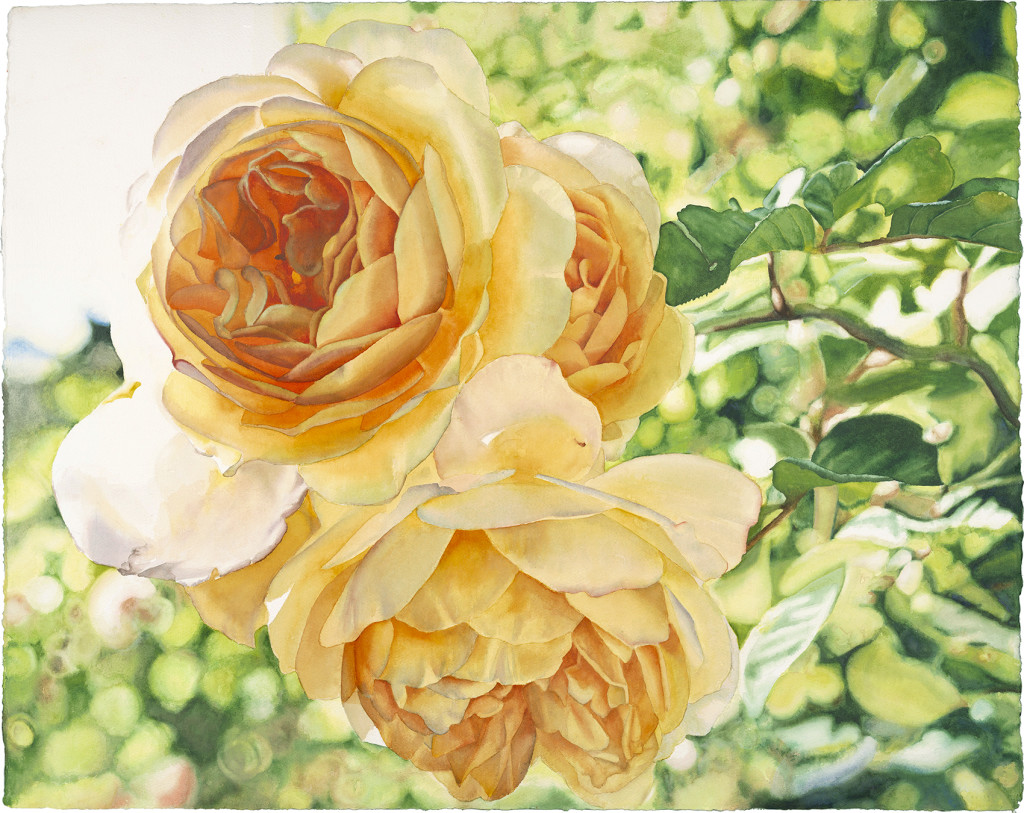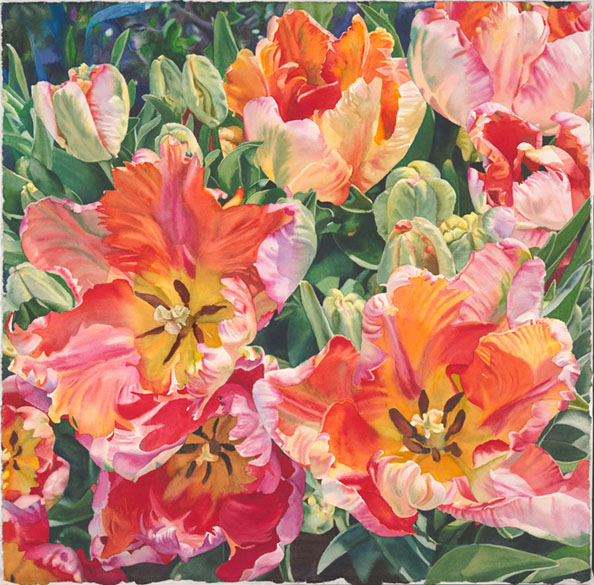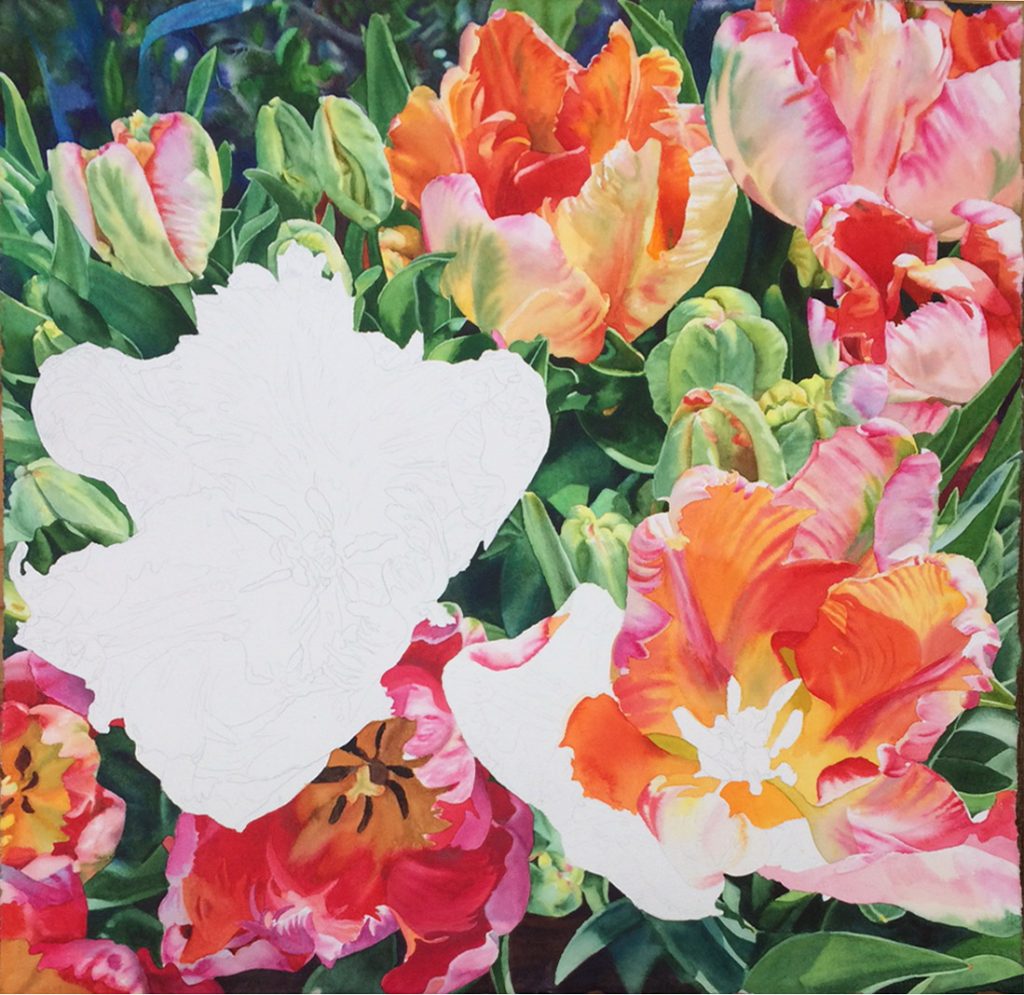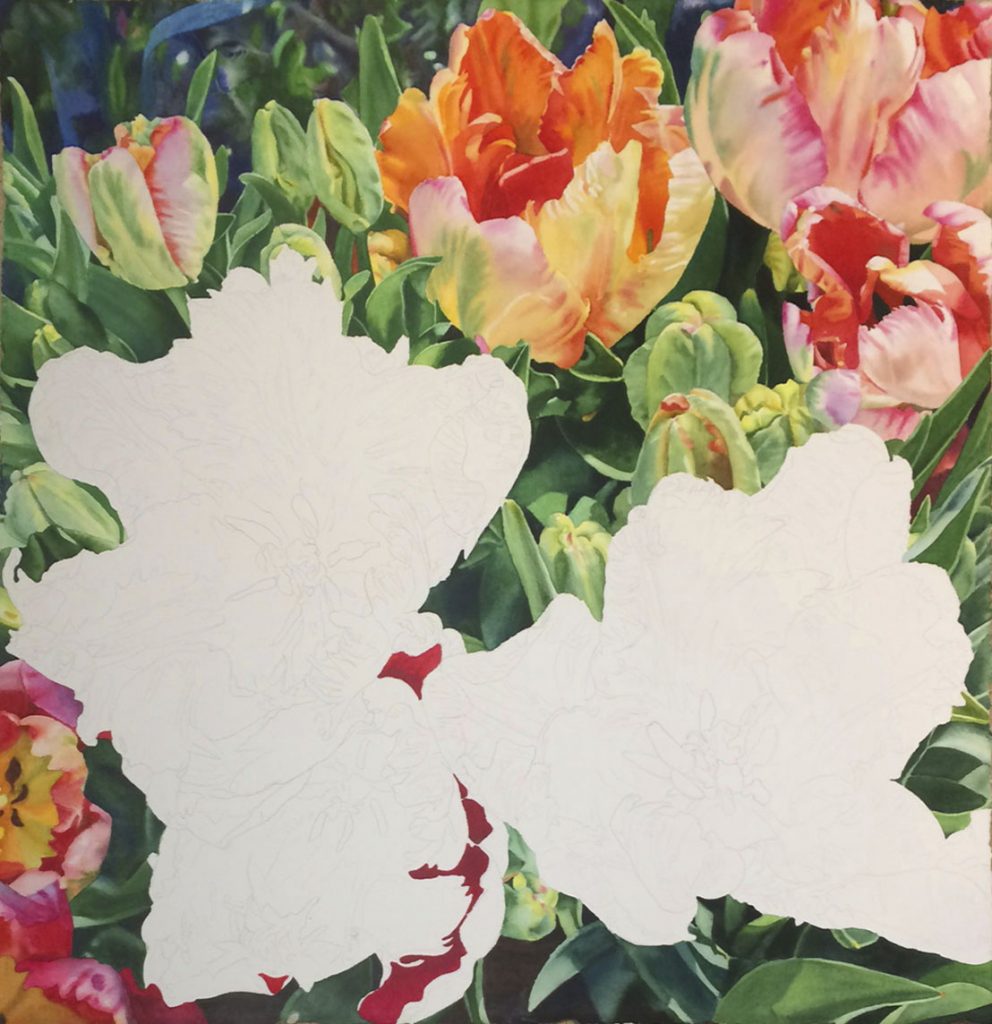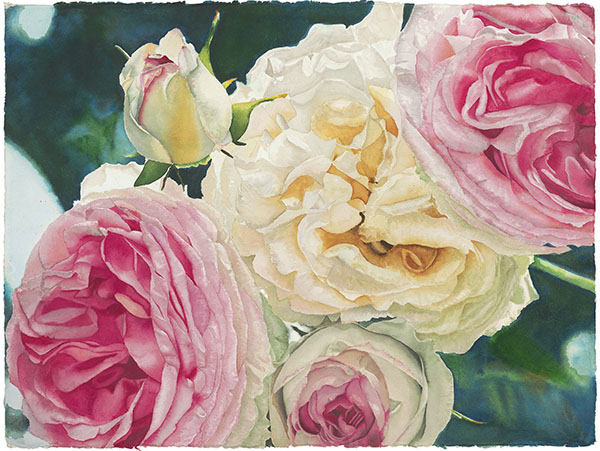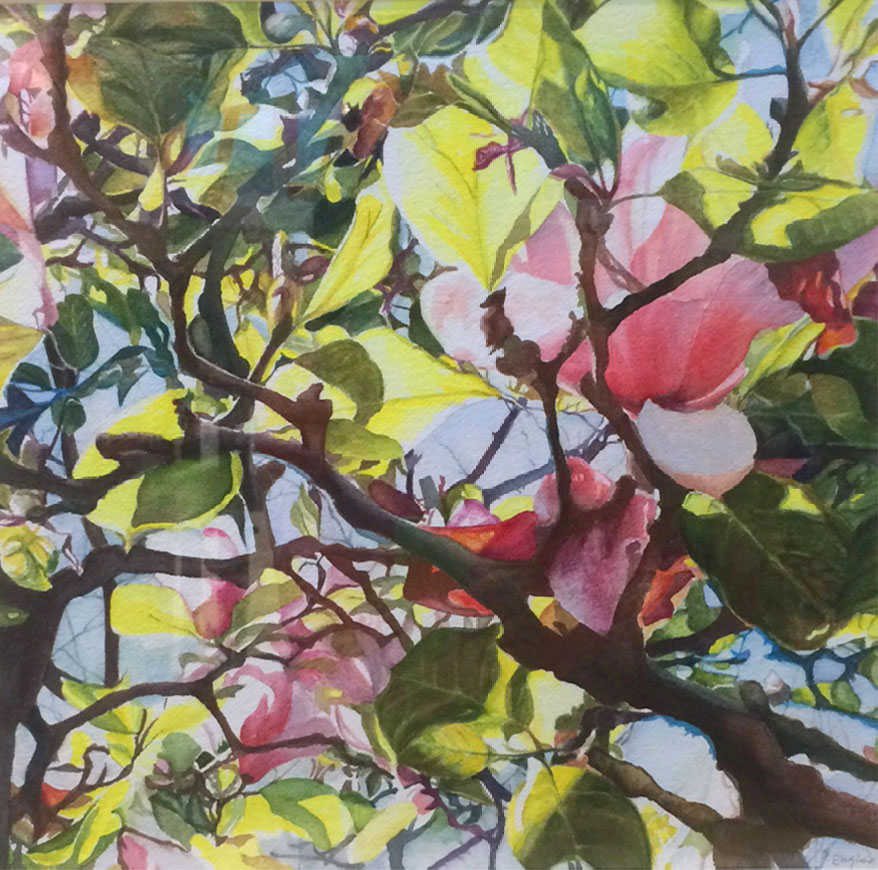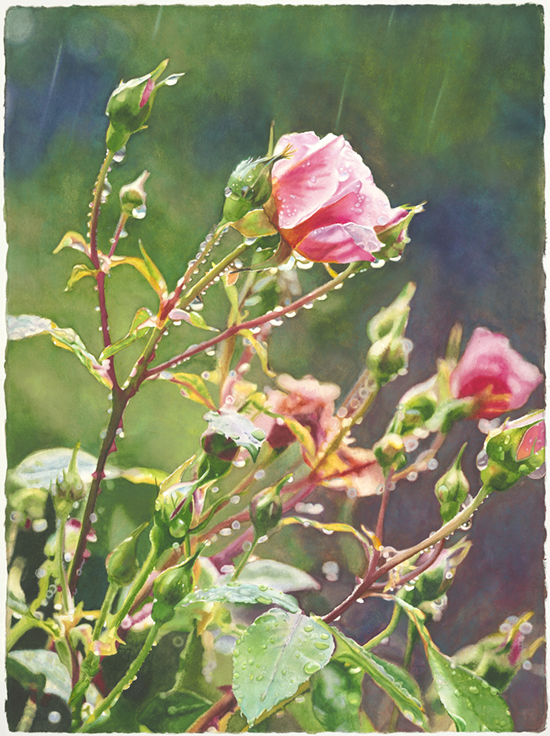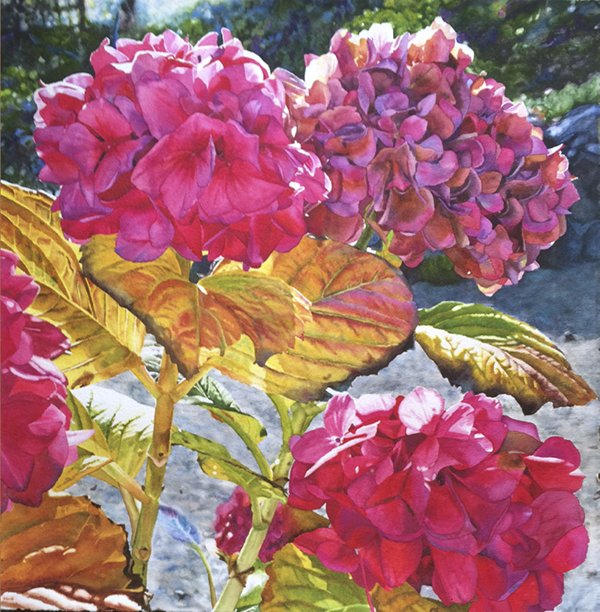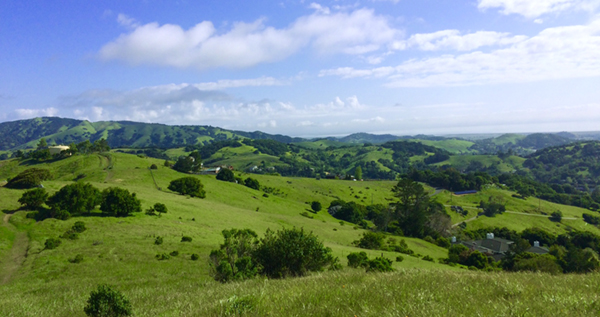June 14, 2017 – Learning to paint fuzzy
- At June 14, 2017
- By Cara
- In Life Stories

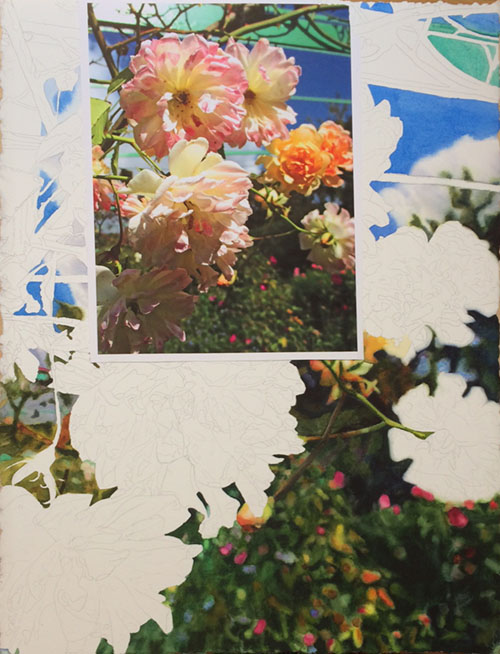
The painting I’m working on – I got the hard part done first – the fuzzy background. I still don’t find them easy!
Do you ever wonder who ate the first artichoke? Who saw this prickly, thistly thing and thought it would be edible? I ask myself these questions all the time – appreciating having been born in a time when so much has already been figured out! I think of all the people who perished by eating poisonous things – before we had ways of knowing what was poisonous versus what would provide the nutrition we need to stay alive. It’s no small thing! In the time of human history – which has just been determined to be another hundred million years older than previously thought – there has been a vast body of knowledge acquired. And with the advent of the Internet during the tiniest last bit of that history, a huge part of all this knowledge is available with a few taps on a keyboard. It’s mind boggling! As a student of how we learn I see the part that information plays – but it only just cracks open the door to learning how to do something.
It seems there are (at least) two kinds of learning – either we gain information via reading, listening or watching, or we have to plunge in and do something. I’m a compulsive learner – especially the information gathering kind. I love knowing just for the sake of knowing and I also know it can take me over! I love the other kind of learning too – though it does not come nearly as easily. I find it empowering to have skills. I’ve learned to use knives in the kitchen, to set ceramic tile, to handle plants in the garden, to make my own clothes, embroidery stitching, cross stitch and needle point – though I can’t handle knitting needles for beans! I find it very satisfying to be able to do things with my hands. It’s no surprise then that I ended up doing something tactile, making these paintings. The thing about learning a skill is that it’s not as easy as running your eyes across words, you have to move your muscles and interact with stuff – with materials in the physical world.
Sally Ragusa, someone who is dear to me, is a student of mine from Arizona – she came all the way here to Larkspur to take the color workshop last year. As I’ve been painting my way through this pretty intricate “fuzzy background” in the past week I have had Sally’s voice in my head – asking me to teach how to paint out of focus. The truth is as much as I can describe what I do, with every single one of these backgrounds I find my way through. It’s not just one technique I follow throughout. Sometimes I do one thing sometimes I do the opposite. So, Sally, here goes. I’ll describe what I’ve observed.
- First off, there is the physical-ness of paint and water. I’ve come to see, even visualize in my head, how the paint is a whole bunch of particles. In a light, thin wash, there are a relatively small amount of particles suspended in the water, and a thick, heavy layer of paint has just enough water to make lots of particles fluid. Thick washes have more capacity to push than a thin wash – more particles, more “muscle.”
- Next you must know that it’s all about the water, how much and where it is: on the brush, on your paper and in the wash on the palette. The late artist and teacher Susan Adams used the analogy of tea, milk and cream. The more water the more movement and the less control you have.
- Remember this: the water will always flow from where it is to where it isn’t – on the brush, paper and palette.
- The caveat to this is that without a minimum amount of water it won’t flow at all. Just as a damp, wrung out sponge is much more absorbent than a dry sponge, if you want to use your brush to lift some water off your paper, it works best if your brush is a bit damp. If you want your paint to flow onto your paper, it must be at least somewhat damp, otherwise it takes the brush to move it around.
- The whole idea with painting fuzzy is to create a narrow transition where the particles of paint taper off from a more concentrated application – such that you have no hard edges, while still controlling the contours of the shapes.
With these fundamentals in mind, here’s what I find myself doing:
- Paint a very concentrated, heavy wash with a small brush (I use a 6 most often) with little water onto damp paper.
- Then sometimes I use a clean, damp brush to lift or “reshape” the paint while it is still wet.
- Paint a shape on dry paper then clean my brush and run a damp brush along the edge of the shape, washing my brush frequently as I go.
- Paint “wet next to wet” by painting a shape and then right away painting another shape in a different color right next to it, so that the pigments can blend. This works best when both are relatively similar concentrations of paint. If one is thick and the other thin, the delineation between them won’t be as clear – one will spill into the other.
- Paint light colors first, knowing that when I paint an adjacent darker color I can soften the edge of the darker shape.
- Paint dark colors first, softening all edges, taking care to not stain (too much!) the areas that will be light in color.
- Use a more stiff brush (such as one I’ve worn the tip off of ) to lift out shapes from a dry wash – I do this often to make what I call “light bubbles.”
- Use a scrubber to erode the sharp edge of a shape that has dried hard – one that got away from me. It doesn’t take too much scrubbing to have the edge look soft. Note that this has the tendency to scuff up the tooth of the paper which impacts how new layers of paint will appear. It also has my painting look “scrubbed” and lately I’ve been working on avoiding using scrubbers if at all possible.
- Layer over using any and all of these ideas when what I’ve done on the first past isn’t “there” yet – after the first layer has dried.
Painting this way is a challenge – it can be even frustrating. But know it’s possible to learn how. I look at my earliest fuzzy backgrounds and see an enormous difference from what I can do now. And I’ve witnessed the same evolution in several of the artists in our groups – those who have been intent on practicing it – which is what it takes to learn a skill. You can’t just read about it. Though I hope that reading what I’ve described about painting “fuzzy” is helpful – I hope it can to get you started. But ultimately, it’s a solo journey. Your hand has to be on the brush dipping into the water and paint, putting it on the paper to see what happens with each variable – of paint, water, brush size and stiffness, and drying time. The other thing it takes is patience with yourself. I’ve painted dozens and dozens of fuzzy backgrounds and I still feel adrift. Ours is a wild medium, one that doesn’t take to being readily tamed.
But painting in watercolor is home to me. I’ll spend the rest of my life – as long as my hands, eyes and brain allow me to – in partnering with this medium to bring beauty to life. One of the things that keeps me going is knowing you are right here with me.
Love,
Cara
June 7, 2017 – The two faces of color
- At June 7, 2017
- By Cara
- In Life Stories

I’ll never forget her question: it was at my second festival in San Anselmo 9 years ago, a woman held up a print of “Blossoming Hope” and asked if I “had this available in red?” It took me a second, but then I realized that she didn’t recognize it as a piece of artwork, but rather like drapery or a couch cushion! After all, fabrics in a particular pattern are often made in different color schemes. I know she didn’t intend for her question to sound ridiculous to me, she indeed liked my painting! And I get it – red just went better with her décor. I found it within me to tell her in a pleasant voice that I had only painted that painting of yellow roses. Since she wanted a print, with the wonders of Photoshop, I could have attempted to modify it, making the roses red, but I couldn’t go there. Since I’ve made my life with color this is one of the more memorable situations to have shown me how completely subjective color is. And yet, we make art and live our lives in a world where everything we’d like to do with color is not possible. We must come to terms with how our ideas about color can bump up against its limits – and how each of the paints we use is much more than just a color.
Color is a rather abstract idea. It doesn’t exist without something – even just light – to carry it. In fact, color really isn’t anything at all – it is a reflection of part of the light spectrum. The nature of the substance it is reflected from is such that it absorbs all the light except for the color we see. Color also is energy. There is less energy in violet than there is in red – which must have something to do with the length of its light waves. Energy varies from color to color as do our responses – which are as individual as we are. Very vibrant color is enlivening to some, and overwhelming to others. Muted, neutral colors are boring or dull to some of us, while to others they are calming. I’m making choices for some new finishes for our kitchen and I’m finding it a challenge for this color-lover – there is so much grey out there!
Adrienne Rogers in our Friday group brought back for me a wonderful book from one of her trips to Boston called “ROY G. BIV,” by Jude Stewart. Its subtitle is “An Exceedingly Surprising Book about COLOR.” For any of you who are as into color as much as I and are amused by fascinating facts and stories, it’s a book for you. It’s filled with all kinds of meanings and associations for colors and our relationships with them – in all their shades. Did you know that many years ago, pink was for boys and blue was for girls?
I love this quote from the book:
Color is like sex. It’s mysterious. It’s unknowable. It never looks the same twice. No two people see the same thing. I once went to China on a cruise ship. Eight hundred of us got off the ship wearing white, because it feels festive and shippy and says “I’m on a cruise.” In China white is the color of mourning. We looked insane. – Stephen Drucker, editor-in-chief, House Beautiful
Within this abstract world of our ideas, inclinations and preferences for color, those of us who work with it have to do so the real world. The challenges of seeing, capturing and attempting to re-produce color are threaded throughout the entire art making process – and they continue when we attempt to share images of our finished paintings. Living with the variation and imprecision in color is a fact of life for artists.
When we see something as we go about our lives that we’d like to paint, many of us start by taking a photo of it – and here’s where our color challenges begin. For the most part our cameras do a decent job of capturing color – way better than my memory can! But cameras really cannot capture exactly as we see; red and dark pink are notoriously difficult to capture accurately. From there our device displays and printers each bring in their own color interpretations. With all these variables the color in our images are more often different from what we saw in real life.
Then there are the paints-pigments that are available to make our art with. It’s a very common misconception when we begin to use art paint to think of the different colors of paints as different versions of the same basic substance. I thought so when I first started! But, the pigments that color our paints come from very different sources. Most modern pigments are created by chemists in the lab, but there are still plenty of them in use today that come from ground up earth and stones – as they have for millennia. It’s not uncommon to see a color in an image and have a hard time re-creating it with paint. I have a big collection of paints in the pink-fuchsia-magenta range, in my attempt to find a certain favorite color! And still there are hundreds of colors of art paint available and I remind myself is that no one ever looks at my paintings and thinks they are lacking in color!
The pigments in our paints have qualities in addition to color we must learn about in order to get the results we want. Pigments can be transparent or opaque, they can have very tiny particles that dissolve into the water creating clear layers of color – or they can be comprised of larger, heavier particles that settle out of the water, creating texture. They can be easily lifted or they can stain our paper. And one quality that I pay particular attention to – they can be “lightfast” – resisting fading as they are exposed to light, or they can be “fugitive” – meaning they will indeed fade or change color over time. There is so much to know about our “colors” beyond the colors we see as we paint our paintings!
So that I can better help those who come to learn to paint from me, I have tried very hard to observe what is going on with the paint and the water as I make my paintings. The thing I’ve observed and attempt to explain is how pigment, as it is mixed with water is a physical substance. The amount of paint, the amount of water, and the ratio between them, all make an enormous difference in what happens as we paint.
I do know a lot about color, I can recognize a number of pigments based on their color, I can see color in color – such as the green in a grey or a blue in a violet-maroon. I can because I have paid careful attention for all these years I’ve been painting to what is happening as I am painting. I’ve said this before, but how and to what we pay attention creates our world. I’ve created a world for myself that is filled with color.
I have a real relationship with my paints at this point. I recently put together a new, smaller palette of paints to take on a trip with me. I filled the wells in the palette with only the paints that I use often – those that I love the most. When I looked at the collection of paints, my thought was: these paints are my friends! I don’t regularly provide a list of my paints to students (besides a starter list of student level paints for those who are just setting out and need guidance). I resist sharing my paints because I don’t want you buying these paints just because I like them. I want for you to discover what paints are your friends.
It’s no secret I’m inspired by color. Color and the illusion of light weave through just about every painting of mine. I need color, I experience it as nourishment and couldn’t imagine wanting to go on living in a world without it. And to make art we need to also learn how to work with color in the world – in our photos and digital images – and in the real substances that are our watercolor paints. I know… there’s so much to learn – even for me! And I didn’t even start into the whole idea of mixing color!
With my appreciation for you in my world,
Cara
P.S.: I’m offering the “Get Intimate With Color” weekend workshop this summer – a “color camp for grownups!” July 7-8 (Sat-Sun) In Larkspur, CA. It’s a great way to get started with color and with painting in watercolor. No experience necessary – really!
Contact me for more information. I’d love to have you join us!
May 31, 2017 – Painting the Light
- At May 31, 2017
- By Cara
- In Life Stories

During Marin Open Studios earlier this month, I was paid a visit by two lovely people – Trinette and James – who I’d met at last summer’s San Anselmo festival and they took the Get Intimate with Color workshop right after that. Trinette told me that they were continuing to paint – or at leasthad been exploring color – which I love to hear. James said that he missed the Special Saturday in January where we looked at what it takes to “paint the light.” I know that I’m doing what I’m meant to in this life in moments like this – because what I said next came through without hesitation, as if I had just prepared myself to teach the class right then. I rattled off four things it takes to paint the light. I thought I’d share them with you today.
Painting the light…when you think about it, it’s an interesting thing to consider. It’s not quite like painting certain shapes or textures – light is less definable or describable. But we do know it when we see it – it’s probably the most frequent comment I hear about this art that is coming through me – that my paintings have captured “the light.” In looking at how that is, I’ve come up with these four things.
The first is you must start with the light. All of us in our watercolor community – as do many artists everywhere – use photo references. This is particularly helpful if what you want to do is paint light. Light is fleeting, ever changing and the camera saves the light for us as it was in the moment. Looking through photos as potential paintings for the last 17-or-so years, I’ve discovered a light meter that lives in the center of me. I have a response in my body when a photo has the sense of light that is worth painting. I take a quick breath in – almost surprised by it. There’s even a sound that is part of the reaction – it’s close to an “oh” – but not quite. I want to be taken by my initial photograph – by the light it captured. In these two photos, can you see which one gave me that reaction and which one didn’t?
Not every single thing I’ve painted has shocking light like the photo that inspired “Hallelujah” (on the right), but if it doesn’t there needs to be something else that evokes magic for me – like the sugar crystals in “Jellies from Hédiard,” or raindrops in “Raindance” below. In order to sustain me over the many hours it takes to make a painting, I need to be enchanted by some quality in the image. What I’ve also discovered is that I – at least – can’t fake it. I’ve tried increasing the contrast of a photo in Photoshop and it just doesn’t work. If it’s not there to start with I can’t create the magic.
I just saw the Monet, The Early Years exhibition at the Legion of Honor in San Francisco on Monday and he, along with many others over time, painted plenty of paintings of subjects under grey skies. The paintings that grabbed, though, me were those where sunlight created contrast – these paintings shimmered from all the way across the large gallery rooms. This said, if what moves you is to paint the softness and subtleness of diffuse light – you go! We are all called to express in our own way.
The second is particular to watercolor – you have to save your whites. Watercolor paintings are most luminous, most striking when the whites and very light tones come from the white of the paper shining through – rather than from white paint. White paint has a density, a dullness that reflects quite differently than white paper. To support myself in saving my whites I always start with a strong drawing – I do all my composing digitally so I have the support of the drawing and my reference image to show me where the whites are. Then, it takes focus to pay attention as we paint. When I’m headed into a new section of a painting the first question I ask myself is: What is the lightest color that isn’t white? This has me notice not only what light color I will paint, but what I will not paint – what I will leave white. It takes practice to be able to pay attention in this way – both in observing our reference image and in where we put our brush to the paper.
Third, you have to get your darks dark enough. Contrast is what grabs us in a painting – contrast is what gets the viewer’s attention. There is no light without dark. A blank piece of paper is all light, but it’s not interesting until we put some darks on it to show us where the light is – by blocking out where it isn’t. Creating darks can be a challenge in watercolor. Because our paint is diluted with water, there is a tendency to have thin washes which don’t create dark-darks. What you want is not to paint straight from the tube – you do need to add water – your paint should always be fluid. Getting dark enough means having enough water and enough paint. You might watch this video as I painted the last part of “Eternal.” With a dense mixture of paint and water, I painted a smooth layer of paint that obscures all the white of the paper in one go. In order to paint light, don’t be afraid of the dark!
Lastly, you have to be very clear about where the light and dark are. Mostly what this means is that the lightest parts of your paintings must be the only places with the unpainted paper. I find myself pointing this out frequently to the artists in our groups. The light areas in the shadows often need to be made a bit darker. We are oriented towards saving our whites – this is good! But then as we finish, we need to look at the overall picture. Evaluate where the brightest parts of your image are – the whitest whites should be the only untouched paper. Everything else should have some amount of paint on it.
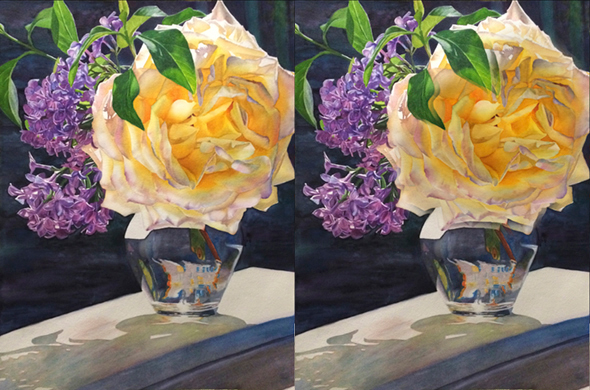
I had to make some of the light parts of the rose darker in order to have the light at the top read.
I love that there is a mystery to art, that we can look at a piece of art and wonder “how did they do that?” But for those of us who are called to make it, I also love that there is often a way to break it down and dispel the mystery – so that we can do it too! Because the thing that makes our art ours doesn’t require that we keep secret how we do what we do. The art that comes from each of us is unique and precious because of the one-of-a-kind instrument inside each of us that receives messages from the world to “paint this” – and, because just like our handwriting – no one will put the brush to the paper or canvas as we do.
Maria Popova’s Brain Pickings a week ago included this post which seems the perfect way send you out into the world – this world we are living at this moment. A collaboration by an artist and a writer, it’s a charge for those of us who are drawn to the light. I’ve ordered one for my studio – the rainbow version (of course). They are also available in black and white and red, white and blue. The link to order is in Maria Popova’s post.
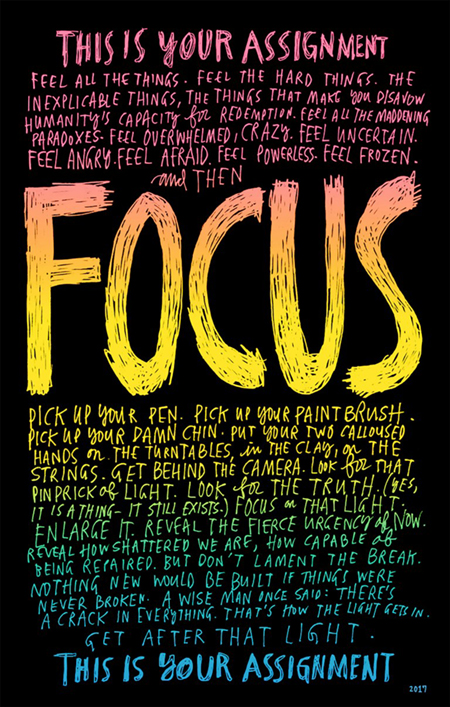
Illustration by Wendy MacNaughton, words by Courtney E. Martin
“This is your assignment.
Feel all the things. Feel the hard things. The inexplicable things, the things that make you disavow humanity’s capacity for redemption. Feel all the maddening paradoxes. Feel overwhelmed, crazy. Feel uncertain. Feel angry. Feel afraid. Feel powerless. Feel frozen. And then FOCUS.
Pick up your pen. Pick up your paintbrush. Pick up your damn chin. Put your two calloused hands on the turntables, in the clay, on the strings. Get behind the camera. Look for that pinprick of light. Look for the truth (yes, it is a thing—it still exists.)
Focus on that light. Enlarge it. Reveal the fierce urgency of now. Reveal how shattered we are, how capable of being repaired. But don’t lament the break. Nothing new would be built if things were never broken. A wise man once said: there’s a crack in everything. That’s how the light gets in. Get after that light.
This is your assignment.” – Courtney E. Martin
We are the light-seekers. Artists: Go, seek it – and paint on!
With my love,
Cara
May 24, 2017 – When whispers become passions
- At May 24, 2017
- By Cara
- In Life Stories

There is this idea in our culture that what we should do is find our passion. What’s more, we hear that this passion is like a switch – you come upon a way to channel your energies and boom: You fall in love and are lit a-fire with the burning need to do this thing – at all costs. It does sometimes happen this way; I had an airline pilot, a captain on 747’s, take a color class once. She said that the first time she took a lesson in a small plane, she was hooked. She sold everything she could to take lessons and made becoming a pilot her whole life. My sense, though, is that this is rather rare – mostly it’s not how it goes. Much more often, finding what we would re-arrange our lives for isn’t quite as immediate or unequivocal. How is it, then that we who aren’t “struck by lightning” can end up living our passion?
I’m asked quite often by those who have just met me how long I’ve been painting. The answer I give them is that it’s been many years since I started, but if my painting life were a mathematical curve, it would be exponential – relatively flat for a while, and then in a short time it shot up. Day one was a Saturday in June of 1992 – 25 years ago next month. My mom and I thought it would be fun to take a one-day, adult-ed class: Painting Flowers in Watercolor. My first painting was a somewhat awkward blue-violet Dutch iris on a quarter sheet (11”x5”) with a plain white background. I found the drawing frustrating, but using color was fun – yet still no flaring passion had yet been sparked.
I went home and over the next few weeks painted three more quarter-sheet paintings of tulips, sweet peas and a big, pale pink camellia. But after that, because my life at the time didn’t support my being freely creative, my energy and impetus to paint petered out. Looking through my stack of early art, there’s evidence that I did paint a bit in the years that followed, but only sporadically – usually on vacation. More farting around than passionate!
About the turn of the century, when my Joseph and I had settled in to doing life together, I picked my watercolors back up again with a bit more enthusiasm. But painting didn’t really grab ahold of me until two major circumstances impacted me – one internal, the other external. In 2004 came the unthinkable realization that I wasn’t going to have any children in this life. This enormous disappointment left a chasm in my soul that sent me looking for something to put my energies into – something more worth spending my life on than working in the corporate world. The external force came in 2007 when I started showing my work – having an audience put a real fire under me to finish my paintings.
Ten more years down the road and I have come to know this life and these paintings as a direct outcome of how my life unfolded. I love to paint, I love working with color, I love supporting others in their painting process. Just recently I’ve started to notice something else – a deepening sense of appreciation for my paintings. I was in conversation with a gallery owner from out of state about representing me and my work. Looking at my website she expressed interest in my most recent paintings. The idea of crating and shipping these paintings I’ve just finished – the ones for which I still can feel the struggle of making them – brought up a clear “no” from somewhere inside. I want to have them close by – to be able to show them myself for a while first.
In one of my recent posts on the Beatitudes for Artists, I said that if there is one thing to pray for in becoming an artist it is this: an irrepressible desire to make it. I quoted Renoir as having said that for him the urge to paint was as persistent as the urge to pee. When I first read this in the margin of one of Julia Cameron’s books, I wanted to paint that badly. (It’s interesting, isn’t it, how I had a desire to have the desire?) So how and where do we get this desire? Initially it comes from the mysterious place that is the source of everything that makes us us. It’s this place that whispers “watercolor” or “poetry” or “the piano” or whatever it is we hear.
Then what? In my experience, it happens more like my exponential curve – we try it once, have a positive experience and then our desire grows a bit if we find it enjoyable and have had some level of success at it. This then makes us want to attempt to do that again – and/or to try something else. For some of us, at some point, painting – or whatever is our art – becomes what we do and who we are. We get to the point where we can’t imagine being without something to paint. Before the one we are working on is done, we are already considering what we’ll paint next. We can even feel a bit of panic if an idea isn’t readily arising.
There are other factors that come into play. Working a full time job, moving house and home, and serious Illness – ours or a family member’s – are often what use up our energies and keep us from creating. But – as in my experience – loss can actually have a catalyzing effect. After the acute grief has passed, loss can re-orient us; it makes a space in us that pulls away our resistance to create. Looking at it, these circumstances are often out of our control, though. We can’t really avoid life’s big obligations and we never go about seeking life-changing loss.
Lately I’ve been questioning the whole idea (that is so very American) – that we can do anything we want to. That, with enough hard work and commitment, whatever we set our sights on is a real possibility. This is a very attractive idea – one that calls to people from all over the globe – and there are many examples of famous lives that prove it to be true. But I wonder just how universal it is. It takes a huge amount of desire/energy to overcome any circumstance and to sustain the commitment over time – in order to change our lives in a big way. I wonder just how many of us can self-generate the kind of will that can keep up the energy necessary. And then there are those of us whose lives are shaped by responding to what comes our way, rather than from a fire that arises from within us – a feminine rather than a masculine orientation.
I wanted to need to paint like Renoir did, but I didn’t actually rearrange my life to paint until circumstances arose that both stripped away my inner resistance and gave me a reason to. The way I know myself to be, the way I am wired, I can’t imagine it having gone any differently. So what does this mean? Should we just be fatalistic about our desires and our creative lives? Maybe. But there is another piece. The thread that has woven through my life in all of this has been to become more and more awake and present to my inner and outer life. I first learned – and since have made it a practice – to pay attention – to my desires, to my pain, to what is going on in me and around me – so I can hear the messages that life has for me – so, then my responses can become more conscious and intentional.
I once read Victoria Moran advise to “live the chapter we are in” – as opposed to a chapter yet to come. If we are caring for someone we love, or are having to work very hard in some other way, we are pulled away from our creative work, then this is the chapter we are living. Not being able to pour ourselves into making art is normal. I’m finding myself, just as I was last week, ending with the question that I started with still lacking a pat answer. Passion, where it comes from – and how it sometimes grows and sometimes doesn’t – is still pretty much a mystery to me. I don’t question that we hear these whispers, though. What we can do is honor the whispers, offer them our appreciation and hold them for safe keeping in our souls, knowing we will act upon them when life turns the page to the chapter that is theirs.
With my love,
Cara
May 17, 2017 – Painting the truth
- At May 17, 2017
- By Cara
- In Life Stories

Marin Open Studios 2017 has just passed, which means I spent the past two weekends hanging out at my mom’s real estate office in Larkspur, my artwork all over the walls, as people came in to see it. Witnessing the response to this art that I make from others – many of whom are complete strangers – is an interesting part of being an exhibiting artist. I’ve come to realized that paintings – mine included – emanate a certain energy that some people can sense. It’s like a radio station that is picked up by an inner receiver of that particular frequency. But it’s curious to me – what is this transmission? How is it that art and people have these connections?
It is certainly very individual. There are plenty of people who either don’t even notice the art or, if they do, seem not at all interested. My “studio” is a storefront space in a commercial district, giving my art the opportunity to be seen by passers-by who wouldn’t be walking by our house in a residential neighborhood in Fairfax. People go by who are headed to the movie theater, the nail salon, the burrito place next door. It is often assumed that I’d be busy all day with people seeing the art through the windows and wandering in, but even with a Marin Open Studios sign on the sidewalk inviting them in, not very many of those who weren’t already planning to, actually do.
Last Thursday, someone did. It wasn’t even the official “open studio” time – it was during our painting group. With nine or ten artists crammed into the space – lots of talking and activity, a woman walked in, almost in a trance. Looking around she asked whose art is this? Someone pointed her to me. She was on her way to a lunch at the Left Bank on the corner and was drawn in by my art. It turns out she lives in London and was leaving town that evening. She walked out having purchased three large prints of roses – completely unplanned. She is one whose tuner picked up the frequency that Life in Full Color sends out, that’s for sure!
A new source of wisdom and inspiration has come into my life: brainpickings.org – the site of Maria Popova, a Bulgarian-born Brooklynite. She writes this beautiful and fascinating blog on culture, literature, art, history and other human endeavors, citing extensively from her sources. I’ve just recently become a regular follower – and in the past few weeks every Sunday’s digest has provided me something that relates to this exploration of mine of what it means to be a human who makes art. I bookmarked this post from a few weeks ago where she reveals Ursula K. Le Guinn’s take on art and its message – from the perspective of the art-maker and from its viewer.
Maria Popova begins with this statement: “Art transforms us not with what it contains but with what it creates in us — the constellation of interpretations, revelations, and emotional truths illuminated – …” And then she quotes Ursula K. Le Guinn:
The kids ask me, “When you write a story, do you decide on the message first or do you begin with the story and put the message in it?”
No, I say, I don’t. I don’t do messages. I write stories and poems. That’s all. What the story or the poem means to you — its “message” to you — may be entirely different from what it means to me.
The kids are often disappointed, even shocked. I think they see me as irresponsible. I know their teachers do.
They may be right. Maybe all writing, even literature, is not an end in itself but a means to an end other than itself. But I couldn’t write stories or poetry if I thought the true and central value of my work was in a message it carried, or in providing information or reassurance, offering wisdom, giving hope. Vast and noble as these goals are, they would decisively limit the scope of the work; they would interfere with its natural growth and cut it off from the mystery which is the deepest source of the vitality of art.
A poem or story consciously written to address a problem or bring about a specific result, no matter how powerful or beneficent, has abdicated its first duty and privilege, its responsibility to itself. Its primary job is simply to find the words that give it its right, true shape. That shape is its beauty and its truth.
She’s speaking about writing – as her medium – but I know this equally applies to visual art. And I’d never considered this before – that there is a truth that our paintings hold. We paint what we paint – for its own sake – for the sake of whatever we find worthy of our time and effort. What happens next is out of our hands. Ten years ago, my friend Vicki was one of the first buyers of my art. She bought Paris Roses. She told me that it took her to a place inside that she didn’t even know existed – a place that was both feminine and strong. I had just painted roses that I thought were beautiful and Vicki received a message of truth.
Several weeks ago I went to the reception for a show of watercolors by Paulette Engler, one of the original members of our Thursday group. Paulette is amongst those who paints the most regularly and she shows more frequently than any of us – even me it seems! Looking across the large room, one of her paintings jumped off the wall at me. I said to myself that I wanted to have it in my life. Though I had watched her paint it over a series of Thursdays, its transmission to me happened in that moment.
She called it “Looking for Blue Skies” and painted it just after the presidential election last year – channeling her intense feelings into it. I saw the largest of the pink flowers with its view blocked by the dark branches, yet I knew that inside that space it lived, pristine and un-marred by any darkness or chaos. Paulette’s painting reveals a truth to me about light and dark and the un-broken, un-breakable-ness at center of all things. I’d stake my life on it that Paulette had no intention to include this message as she was painting!
I love this idea that there are truths that are found, felt, seen, heard in works of art of all kinds – truths that the artist was unaware of until revealed by the receivers of the art. Knowing this has me feel more deeply what it is I’m up to – what we are all up to. But we also should not be over-conscious of it. Ursula K. Le Guinn tells us to stay innocent to it. She says to stay with our process, which for us is the specifics of pencil lines and brush strokes, and let whatever this magic is have its own life. I hear a caution that if we become overly conscious of it we would get in the way of the “right, true shape” of our art. These truths must find their own way, allowing the viewer to find their truth themselves – rather than hitting them between the eyes with our version of truth.
Going forward, as I paint, as I write my paintings’ stories, and as I give them names, I want to hold on to this innocence. At the same time, I want to be ever more intimate with the spirit of my art. Our paintings are our off-spring and I can see the parallels in parents’ relationships with their children. We love them, shape them, support their way into the world. But it’s not for us to say what they are here for, who they are here for. That is up to them. I end this post as I started it, curious as to the mystery of art and how it connects us. I see that it is an enduring mystery – one we will never understand. This feels – to me – just as it should be.
With my love,
Cara
May 10, 2017 – Beatitudes for Artists – Part 2
- At May 10, 2017
- By Cara
- In Life Stories

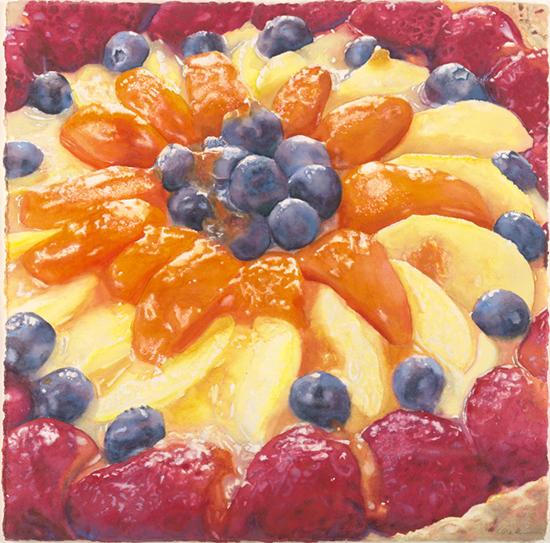
“Fruit Tart – a painting from a decade ago that gave me great challenges. I needed these Beatitudes when I was painting them – it would have been much easier on me!”
This week we continue with the second half of Jesus’ eight Beatitudes that I’ve re-interpreted looking through the lens of making art and becoming an artist.
Jesus said: Blessed are the merciful: for they will be shown mercy.
I say: You’re blessed when you are gentle with yourself and others while in the process of learning and creating, for you will enjoy the process so much more and are likelier to stick with it.
Making art is hard; learning something new tests us. We are forming new connections between our hands and brains, observing the results, practicing, fine-tuning. Our egos prefer to do things we are really good at. So, when we are in the sometimes-clumsy early stages of learning, we expose ourselves to judgement – from the inside and out. Unfortunately (to our egos) there is no way around the learning process. You can’t make the art of someone who has painted 1,000 paintings until you’ve painted 1,000 paintings. And even once you’ve gained a certain level of skill, if you stay alive in your work, continuing to explore and experiment, you continue to risk. What I want for you is to consistently tell yourself that you are doing your best at your current level of ability and inspiration. Remember that as long as you are painting with your highest intentions, you – and your artist companions – are right on track. Being kind and gentle to your creative self is how to keep yourself coming back again and again to the challenge that is making art.
Jesus said: Blessed are the pure in heart: for they will see God.
I say: You’re blessed when you follow your heart in your creative endeavors, when you do not allow your heart to be divided by outside influence and when you trust that your art is perfect and precious, for no one else will ever make the art that is in you.
I believe that we don’t choose what and how to create, rather it chooses us. We don’t choose what we are drawn to. We love what we love; we are interested in what we are interested in. Following what allures you is being “pure of heart.” There is always the temptation to allow your inclinations to be divided by the voices of others – often including the words “should” or “shouldn’t.” And, especially when you are starting out, you may be inclined to have these voices lead you off your unique path. Anything that comes your way as you create – instruction (including from me!), others’ processes, others’ art – is all there to serve you and your process. Trust yourself, trust what you like and don’t like. You and only you hold the vision for your art. When you follow this vision, you create something that no one else in all of time will ever make – the art that only you can bring forth.
Jesus said: Blessed are the peacemakers: for they will be called children of God.
I say: You’re blessed when you are at peace with the imperfection in all things – including your art and process – in doing so you embrace the sacredness of all acts of creation.
Making art may not seem as treacherous as other aspects of living a human life, but on the inner plane it can be. Just look at the history of tortured artists, plagued with addiction and mental illness. The tumultuous inner life of art makers calls for peace – a peace that surpasses all understanding. This inner peace comes from a trust in something much greater than us and it is well worth cultivating. Let any ego-drama pass by, stay with yourself and your precious desire to make what you make. If you really think about it, where exactly does this desire to paint – to paint specifically this flower, or this face, or this patch of Earth – come from? Where does any idea, inclination or inspiration come from? It has to be from some divine source. Operating with a trust in this source takes our small-self out of the picture. At this level we are following divine “orders.” It may seem like we are simply putting brush to paint to paper (or canvas), but we are actually making manifest, making real, something that wanted to become real – through us.
Jesus said: Blessed are those who are persecuted for righteousness sake: for theirs is the kingdom of heaven.
I say: You’re blessed when you move beyond the opinions of others about your artwork, in doing so you free yourself as an artist.
Because of our uniqueness we have a certain strangeness to other people, and with this can bring a kind of loneliness. As much as we need each other for support, to be cheered on as we work, at the most basic level, if it is to be our own work, we must make it alone – on our own. Then, there will always be those who don’t get it, who will dismiss our art – or who even dislike it. It helps to remember that what is said about our art comes from an entirely separate universe of human reality. Tara Sophia Mohr says that feedback (negative and positive) is 100% about the giver of it. At some level it is none of our business what someone else thinks of our art.
This is the culmination of all of the other seven of these Beatitudes for Artists:
- When we open ourselves to making art,
- when we allow ourselves to feel fully what we are here to express,
- when we have appropriate humility about our art,
- when we heed our desires to create,
- when we are gentle with ourselves as we learn and grow,
- when we have the courage to trust in our singular vision,
- and when we cultivate an inner peace about it all,
- then we set ourselves free from how anyone else may see what we make and we are ultimately free to make the art that is ours to make.
As artists we step in to the flow of creation, we become the channels, the vehicles for what is un-manifest to become manifest – through us – our eyes and hearts – and our cameras, pencils, brushes and paints. We then speak with a voice – our artistic voice – that says what we alone are here to say.
I want to offer my thanks to Sister Mary Neill, my amazingly brilliant and oh-so-affirming-of-me spiritual director for helping me understand more fully what Jesus was saying in his Beatitudes, so I could find my way to these interpretations of them. I’m so grateful for her guidance and companionship in my inner life.
With my blessings that your artist-self may be set free –
Cara
May 3, 2017 – Beatitudes for Artists, Part 1
- At May 3, 2017
- By Cara
- In Life Stories

As promised last week, (when I provided you with the context for why I’m doing this!) below are the first four of the eight Beatitudes that I’ve re-interpreted looking through the lens of making art and becoming an artist.
Jesus said: Blessed are the poor in spirit: for theirs is the kingdom of Heaven.
I say: You’re blessed when you first come to making art, devoid of any know-how and afraid to take the first step, for you are opening yourself to a whole new experience of being alive.
We all start at the beginning. Not one of us comes out of the womb with a paintbrush in our hand. We all come to making art for the first time without any idea how it’s done – and there’s no way we could until we’ve tried! There is an innocence, a freshness when we first begin. We have no idea what is to come. To begin requires that we be open and receptive to the art that is to come from us. Because, when you take it seriously and make art-making a regular practice, when you witness the stream of creations coming through you, your concept of yourself will change – forever. We must attempt to retain this openness as we gain skills and competence – which may be an even more difficult thing to do! Competence gives us confidence, which can tend to have us think we know. A perpetual cultivation of beginner’s mind is what keeps us – and our work evolving, growing and coming into its fullness.
Jesus said: Blessed are those who mourn: for they will be comforted.
I say: You’re blessed when you feel deeply, when you let your heart feel the pain of your own life and the pain of the world, then your deepest self is revealed in your art.
Surrounding the physical heart in our chest, the heart that pumps our blood to the rest of our body – is an emotional, feeling heart. This heart is both tender and indestructible. The hurts and disappointments in life teach us to protect and conceal this heart. The blessing comes when we allow this heart to touch and be touched – it’s where we experience awe, wonder, astonishing beauty as well as pain, loss and tragedy. By allowing this heart to feel, we build its capacity. We can withstand our own suffering and thus the suffering of the world. Creative expression very often finds its genesis in the suffering we’ve allowed our hearts to feel. Think of all the human stories of great loss that led to making a difference. I know that I’d not be making this art and living this life if I had not endured the pain of being childless. Ready access to this heart serves our art making as it is the instrument that receives the messages of what our art is – what materials, what subjects, what color palette. It guides our choices, it feeds our visual voice. It is the compass we follow as we share with the world the message that is ours to bring.
Jesus said: Blessed are the meek: for they will inherit the earth.
I say: You’re blessed if you are humble in your creative process, when you do your authentic voice shines through you most brightly.
This one brings to mind something that Ruth, a woman I used to go to church with, gave me – an understanding of the word “humility”. She said humility is a healthy relationship with our sense of self – our regard for ourselves isn’t either too high or too low. We honor and accept our gifts and our shortcomings as they are. I hear people say frequently that they have no “natural talent.” But the gift of creating isn’t bestowed upon you (or not) with a magic wand; because you are alive you have the capacity to create. Holding that you (too) have the capacity to create provides the courage to step in and give it a go. And when we maintain that the art that comes through us has a life of its own, we find it odd to take full credit for it. We become its channel rather than its creator. It is when we allow this process that our art becomes a reflection both of who we are as well as something we’d never have imagined.
Jesus said: Blessed are those who hunger and thirst for righteousness: for they will be filled.
I say: You’re blessed when you have a great desire, a hunger to create – this is the fuel for your learning and creating.
More than talent, more than experience, more than anything else, the desire to create determines what happens in our art making lives. It is what gets us into our first class, it’s what gets us to sit down (or stand up) and actually do our craft. It’s what gets us through the often challenging learning process. It’s what endures the self-criticism and fears. In one of Julia Cameron’s (The Artist’s Way) books I read a quote, attributed to Renoir. He said something like: For him the urge to paint was as persistent as the urge to pee. A bit earthy, but it makes his point! I remember reading that and actually wishing for my urge to paint to be that strong. This was a wise wish. I still don’t experience the desire to paint quite that urgently – it’s more that if I am away from my painting for too long, I get supremely cranky! But I now have the clear sense that there is a body of work in me that is in the process of emerging. I wonder if the desire to paint isn’t the art’s desire – wanting to come through us?! If you long for anything, if you pray for anything in becoming an artist, the most important would be to have the flames of your desire grow. It’s where it all starts and how it’s sustained.
Stay tuned to next week for the second four…
Love,
Cara
April 26, 2017 – Supremely Blessed
- At April 26, 2017
- By Cara
- In Life Stories

You know I’m an artist; you know that I am a guide to those on their own creative journeys – and if you have been reading these posts for a while, you likely know that I’m also a spiritual seeker. My seeking began in my 30’s centered in what would be called New Age spirituality, but now my heart finds nourishment and curiosity in the Christian path. I shiver a bit as I write this. I wonder what you might be making up about my saying this? Even to my ears it sounds freaky – Jesus freaky. Telling you I’m Christian makes me want to clamor to explain – I want for you to know what kind of Christian I am. Because I’m not the kind of Christian that comes to mind for most people in the liberal circles I travel in – or would have come to my own mind thirty years ago.
As were most Americans, I was raised in a family that had its spiritual roots in Christianity, but hardly anyone around me seems to have much connection to that fact. Even our big Christian holiday celebrations – Christmas and Easter – lack much connection to Jesus’ birth and death and resurrection. I have no idea how or why, but I am heaven bent (because “hell bent” so doesn’t seem to fit!) to discover for myself the pearls of wisdom and useful practice in the tradition that has come out of the remarkable life and death of Jesus of Nazareth. And some of what I’ve discovered is such a far cry from my knee-jerk understanding of “Christianity” in my earlier life – that it is astonishing! I know that what I’ve learned is soundly rejected by those who follow more traditional ways of believing. But what I’ve discovered feels right and true to me.
I also see that I am not “all the way in” as some others are. I am still holding on to my rational, figure-it-out mind when considering who Jesus was and is. I don’t consider him my “Lord and Savior,” I don’t even worship him – worship – to me – is for God, the creator of all that is. I’m not sure how I would describe a relationship I might have with Jesus – if I even have one. But I deeply, deeply appreciate that in his time on the Earthly plane he was an enlightened wisdom teacher – whose teachings are as relevant and useful today as ever.
Because I wasn’t raised practicing our tradition, I’ve never read the Bible and don’t have much of relationship with it, either. (Some Christian I am, huh?) Except for one section – the Beatitudes. I do have a relationship with the Beatitudes. I was introduced to them on a trip to Cuernavaca, Mexico in 2003. Led by my then Pastor, Sara Vurek, we spent 10 days staying with the Benedictine Sisters and met and visited with some of the poorest people in the area. I learned about Liberation Theology and the life and work of the beloved Archbishop Oscar Romero, who was assassinated. We went to a church in Cuernavaca that had the Beatitudes engraved on a large exterior wall on its side – surrounded by a garden. “Blessed are those with the spirit of the poor” I read. We were told of how central these words, spoken by Jesus in his Sermon on the Mount, are and the place they hold for those living in such oppressive poverty in Latin America.
A few years later, Evelyn, my mother-in-law, gave me a book called “Reading Jesus: A writer’s encounters with the Gospels” by Mary Gordon. I think it was her relationship with the Beatitudes that really helped me form mine. She writes:
“For many days, I write and rewrite these words by hand and then I am paralyzed. Struck dumb. Afraid to write. Silenced by the depth of my attachment to them, silenced at the example of sheer moral greatness and the sense that after these words there is, perhaps should be, nothing to say.
What kind of life, what kind of living is suggested by the Beatitudes? Perhaps equally important, what virtues are not mentioned… elided, simply left out?
Most striking: the bourgeous virtues. There is nothing about honesty, keeping your word, paying your debts, placing yourself in the right place in relation to authority or hierarchy. Mercy, peacemaking, poverty of spirit, purity of heart (the body is not mentioned here). The sexually well-behaved are not given a place.”
She later writes movingly about the second one: “Blessed are those who mourn, for they shall be comforted” as a “perpetual mourner” having lost her father when she was a child. This Beatitude speaks of the dignity, the duty even, to allow our pain as we mourn our losses, knowing that comfort is at hand.
At the end of January I finished the painting above, and gave it the name “Beatitude.” The Beatitudes are each a paradox: amidst what we’d think of as lesser is really something far greater. On the same plant – at the end of the season – are both the dying leaves and the still-radiant flowers. The name came to me before I started painting it – before even drawing it. It also occurred to me that these teachings from this man who lived two millennia ago could use a higher profile right now – to be more top of mind than ever before in my life.
During my vacation over the following two weeks, I took on the audacious task of interpreting them for myself – from my point of view as one who creates and supports others in creating too. I’m certainly not the first to do this, but every other interpretation that I found online was done by a pro – those who make their lives in this tradition – including Pope Francis.
In the next two weeks I’ll share with you what I’ve come up with – the first four next week and the remainder the week after. I’d so love to hear from you – (even more than usual!). I’d love to know if reading how I see these ancient teachings, looking through the experience of bringing forth creative expression, might meet you.
It’s scary to do this, to reveal this part of me to the world so publicly. But doing scary stuff is where life is really lived. And it’s what Jesus did.
Offering you blessings – and my appreciation for who you are to me,
Cara
April 19, 2017 – Art springs eternal
- At April 19, 2017
- By Cara
- In Life Stories

Fear is a big character when it comes to making art. I see it all the time – in myself as well as in those around me. Last week I received an email from someone who had come into my mom’s office while one of our group sessions was underway. She said she wanted to learn to paint but she wanted private lessons, as she felt intimidated by the work she saw us making. I hear this often – someone comes to get a calendar and tells me that she wants to do something “creative” but has to get over her fear of doing so. I meet someone at a festival who expresses the wish to be able to make work like mine. When I invite her to come give it a try, I can see her almost physically retreat from me. Then there was the customer who, when I delivered a piece of art she’d bought to her house, was so excited to show me her newly renovated “craft room.” My reaction was: This isn’t a craft room, it’s a studio! I completely understand her reticence, though – there is a certain audacity in calling what we are making art. When we sit with a blank piece of paper and begin to draw and then paint something of our own choosing, we are making our mark, we are revealing something of our self into what we are making. There is something in us that craves doing this – I often wonder about what this force is and I think it’s related to the very human need to share of ourselves – to be really seen – the idea of which is both thrilling and terrifying.
Read More»April 12, 2017 – When love leads
- At April 12, 2017
- By Cara
- In Life Stories

Last week at dinner with a couple of the artists in the Friday group, the subject of jury duty came up and I found myself recounting the experience I had when I sat on a jury several years ago. On trial was an undocumented woman from El Salvador, a mother of three who cleaned houses. The charges against her came from an incident in a courtroom when her husband was being remanded into custody. Sitting with her kids in the back of the courtroom, she ran up in protest when she saw him being brought to the ground – he was resisting arrest – and being restrained by several deputies. She ignored the judge telling her to take her seat, prompting several other deputies to physically restrain her too. She was forced to bend forward over the back of a courtroom seat, her head pushed so that her face was buried in the seat – with two more deputies holding each arm behind her back. The charges against her included: contempt of court, resisting arrest and assault of a police officer – in the struggle, one of the deputies, a woman, was bruised on her forearm.
I was amazed how easy it is to end up on a jury panel. If your name is called for you to come up to sit in the jury box and if there aren’t any questions the attorneys ask that would illicit an opportunity to reveal something they might object to, by default you are on the jury. I thought that each potential juror would have been questioned for at least a few minutes, but after stating my only name and what I did for a living, just like that, I was on the jury. The trial process was tedious and an inefficient use of the jurors’ time. We were there from 9am-5pm for something like three and a half days and were in the courtroom for maybe a total of 8 hours hearing the case. There were long lunch breaks and we were left for hours in the jury room while the judge tended to other matters. It was both fascinating and frustrating. But the most challenging for me was the deliberation process.
It was clear to me that this woman was not in any way a threat to society. She had an emotional and very human reaction to a frightening situation. Sure, there are people in her shoes who may have been able to restrain themselves, but what she did – in the scheme of all the crimes are put to a jury – seemed barely consequential. It was bad enough that she had been handled so roughly (we were shown photos of the many large bruises on her arms), then she had been put in custody not knowing what was happening with her children and then her husband was released from custody and left the country, leaving her to fend for herself and her kids. It incensed me that the precious resources of a jury trial were being used this way. I couldn’t imagine why the District Attorney had pursued the case against her!
When our foreperson asked us each to indicate where we were leaning on the charges I was the only one who expressed reservations in convicting her. Yes, we were instructed to make our judgment based on the facts as presented and the law as it was described to us. Based objectively upon that, I can see how the others came to their guilty conclusion – it was clear she made a big ruckus in the courtroom. But I could not help but look at the whole thing from a broader perspective and I saw no justice in convicting her. I hoped that I might be joined by others – but none of my fellow jurors – some of whom were mothers – shared my perspective. There were some tense moments as 11 other people looked at me, silently asking me if I was going to get in the way of having this whole thing be over with.
The resolution arose after one man brought up the idea of a “grand bargain.” He asked me if I might be willing to find her guilty on the two lesser charges and not-guilty on the more grave charge of assaulting a police officer. I sat with this for a minute or so, as they all waited on my response. I realized that given the spirit of compromise in his question, I didn’t have the guts to hold the deliberation up and I reluctantly agreed. After the trial was over I met with the woman and her attorney on a bench by the windows outside the courtroom. I asked why this case was even brought to trial. Her attorney told me that if she had been convicted of the assault charge, the deputies who arrested her would have been immune to any charge she might have brought against them for excessive use of force. The best defense is a good offence. As much as this made sense, it made me even sicker – and it made me feel used.
For a few days afterwards I felt bruised. I felt the injustice of a world that works to protect the powerful against the vulnerable. I felt the loneliness of holding a stance based upon my heart’s deepest knowing – within such a world. And I longed for the strength to have held my ground. I ask myself if I would have the strength now – I so want to believe that I would. I know that if I do ever find myself as a potential juror again, I won’t hesitate to speak up about this experience and the way it has eroded my faith in the criminal justice system in our county.
This is holy week in the Christian world – the week we commemorate the last week of the earthly life of Jesus of Nazareth. Standing my ground in a trial of an undocumented woman is small potatoes compared to his standing before Pontius Pilate and the Roman Empire. He, in all his humanness, certainly had the courage to lead with love. He teaches us to love our enemies, to care most for the least of us, to turn the other cheek. We’ve heard this many times, but putting it into practice is a whole other thing. Take, say loving our enemies. Love those who gas their citizens? Love those on the opposite side of my politics? Even love the guy on the trail who doesn’t control his aggressive dog? Loving no matter what is hard! And to do so often goes against what we’d think would be better judgment. But love is anything but rational.
Leading with love – especially in some situations – can be a radical act. It takes courage, it takes having a well of self-love to draw from and it takes being connected to something greater than us, greater than the whole situation. It’s that third force I’ve been writing about lately – the one that delivers us to another dimension. And as I work this path of becoming more aware and conscious, I see that living this way allows us to be truly free. Not the kind of freedom that is provided by protective armies – or by any kind of armoring, but the freedom of an uncompromised heart. It’s a long-term project to live this way – one that I’m determined to continue to work on.
After a weeks of a news fast, I’m back to reading the paper – carefully – trying not to take in too much rancor. I keep looking for anyone bringing in a broader, more loving perspective into the public discourse that I can hitch my hope to – There is a part of me looking for love to take the lead as it felt it would (for many of us) with the election of our last president. But I’m seeing the world entirely differently now. It appears that change must come from the ground up, rather than the top down. I feel the call for love to lead us from within. So, after my check-in with the world, I’m getting myself right back to making beauty – as art, as making space for others to create in, as caring for people, as meals I cook – in any way I can. It is when love leads that the Kingdom of Heaven is at hand.
With my gratitude for the companionship of your love,
Cara
